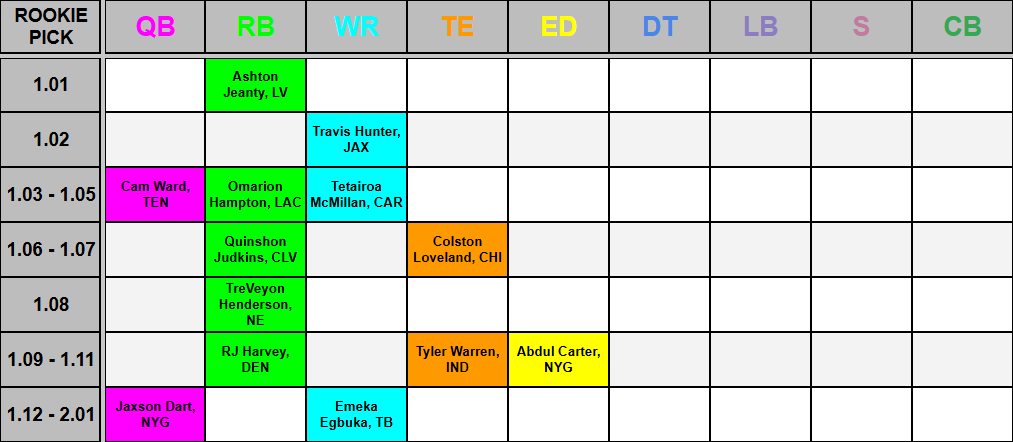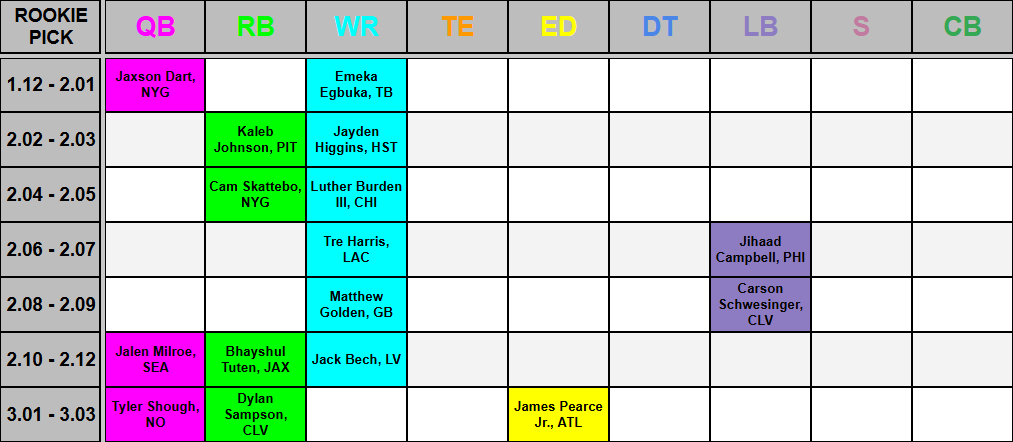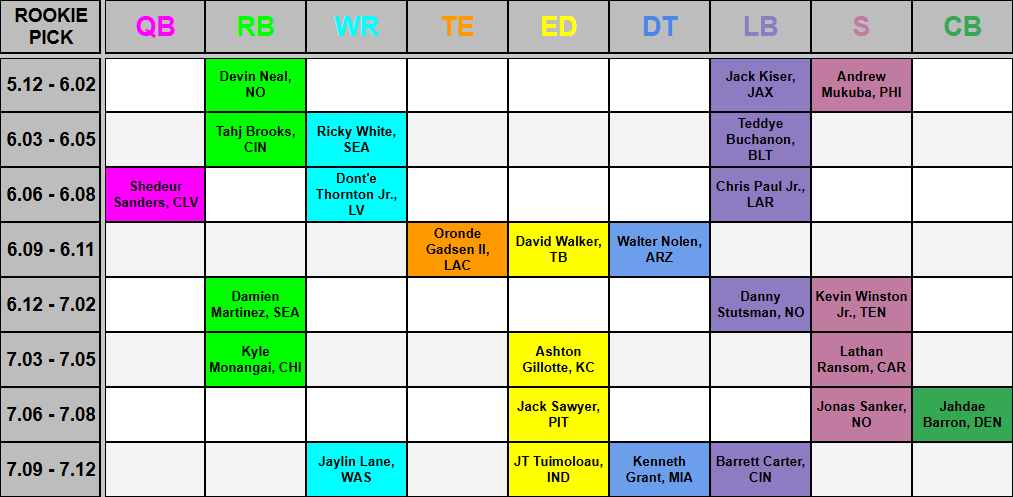- Mixing more of the top quarterbacks into the early portion of our rookie drafts: See where the likes of Cameron Ward and Jaxson Dart make sense to target.
- How quarterback values increasing affects the IDPs: With more quarterbacks entering the fold, naturally, the defensive players will get pushed aside more often than not but find out just where they should be considered.
- Subscribe to PFF+: Get access to player grades, PFF Premium Stats, fantasy football rankings, all of the PFF fantasy draft research tools and more!
Estimated Reading Time: 8 minutes

With rookie drafts starting up in full force, fantasy managers are presented with plenty of different rankings to help them understand which players to value at each pick.
Those rankings are helpful, but it is rare to find a guide that details how to value offense and IDPs combined in rookie drafts — and this is exactly what this draft board aims to provide.
- Offensive scoring is based on standard PPR for superflex formats, with starting roster requirements of 1-2 QB, 2 RBs, 3 WRs, 1 TE and 3 FLEX.
- IDP positions are “true position” settings and based on 2-EDGEs, 1-2-DTs, 2-3-LBs, 2-Safeties, and 2-CBs starting roster requirements.
- For more detailed insight into the IDP rankings, check out the top-50 rookie IDP rankings article here.
The following IDP rankings are based on the scoring laid out below:
PFF-preferred IDP scoring:
| POSITION | SOLO TKLs | ASSISTS | SACKS | TFLs | QB HITS | PBUs |
| DL | 2.5 | 1.25 | 5 | 1 | 2 | 2 |
| LB | 1.5 | 0.75 | 4 | 1 | 2 | 2 |
| DB | 2 | 1 | 4 | 1 | 2 | 2 |
ROUND 1

1.01 – 1.02: Historic superflex drafts have us trained to take the top quarterback first overall, or even second overall at the latest, but it’s important to note that this year is very different from previous years. Not only is this a weaker quarterback class, led by Cameron Ward, who doesn’t project as strongly as past top-five-drafted quarterbacks, evidenced as well by his standing as the 20th-ranked player on the PFF big board. However, there are potentially two elite-level prospects between Ashton Jeanty and Travis Hunter in this class that offer significant upside, even in superflex formats, where both should be viewed as more valuable dynasty assets than Ward. Teams desperate for a quarterback should still select one of these players and look to trade them for a better dynasty quarterback option than Ward.
1.03 – 1.05: Once Jeanty and Hunter are off the board, Ward can more comfortably come into play as a potential option, though still not a lock to be the next pick for those who believe Ward does not have clear-cut top-12 fantasy potential. Both Omarion Hampton at running back and Tetairoa McMillan at wide receiver have a better chance to deliver top-12 numbers for their position right now than Ward does for his, but that doesn’t mean that it’ll be impossible for Ward, whose value in superflex leagues will keep him as a top-five option for most rosters.
1.06 – 1.11: The next range of first-round picks is typically where consensus starts to fade a bit more because different drafters will view these options very differently. Immediate impact players like RJ Harvey, Quinshon Judkins or potentially Tyler Warren could be higher on boards over some of the better long-term bets like Colston Loveland or TreVeyon Henderson. All are perfectly acceptable options anywhere in this range.
This is also where our first IDP should likely come off the board, depending on scoring, but for this format, Abdul Carter is the clear top target on defense. Carter is on par with Will Anderson and Micah Parsons as an edge prospect, and despite landing in a more crowded defensive line room, there’s no concern about him being able to overtake a starting role sooner rather than later in his NFL career. As highlighted in his edge prospect model profile, he owns an ideal potential success rate for the position and should be valued as such, as the offensive hit rates start to drop a bit late in Round 1.
1.12 – 2.01: Jaxson Dart also becomes an option in superflex formats based on the New York Giants‘ first-round investment in him. Dart isn’t likely to start right away as a rookie, but with Russell Wilson on just a one-year deal and Jameis Winston, a likely backup regardless of the starter, also on a short-term deal, Dart’s starting value will come through fairly quickly for those investing in him here, even if we have to be somewhat patient for him to get there.
ROUND 2

2.01 – 2.05: This early second-round range is all about cleaning up the value on offense, either by taking remaining first-round NFL Draft picks like Matthew Golden or Emeka Egbuka, or ensuring that the positive Year 1 situation players like Tre Harris and Cameron Skattebo get scooped up before moving back to the defensive side of the ball.
2.06 – 2.12: The middle to late second round is about the range that the next two IDPs make sense when compared to the remaining offensive options. Jihaad Campbell and Carson Schwesinger are the top options up next, serving as high-end linebacker prospects with great long-term potential to deliver starting IDP value for years to come.
For those non-tackle-heavy scoring formats, it’s fine to wait on the linebacker position a bit and push these names a little further down the line to target any offensive players of interest who are still available.
ROUND 3

3.01 – 3.03: Both Jalen Milroe and/or Tyler Shough are options near the end of the second round and early into the third round for superflex formats. For those aiming for upside, Milroe makes the most sense given his rushing ability, though he may not get a chance to start for a while in Seattle. For teams looking for a more immediate plug at the position, Shough could be in for a starting role as soon as this season, depending on Derek Carr’s injury status. While he isn’t a highly-rated quarterback prospect, there is at least some rushing to his game, with the bigger key being his overall opportunity.
3.04 – 3.12: Once those quarterbacks are gone, even with a few other offensive options sprinkled in, this is typically a nice spot to take shots on some of the better defensive players as offense dries up a little more. Both James Pearce Jr. and Mike Green are personal favorites, considering the potential for an immediate impact in the NFL and for IDP, while Jalon Walker, Mykel Williams, and Shemar Stewart are all first-round talents that can serve as great long-term investments.
For DT-required formats, Mason Graham is the clear top option in these IDP rookie drafts, as he has the potential to play a workhorse role in the middle of the Cleveland Browns‘ defensive line because he thrived as both a run defender and pass-rusher during his time in college. This is the type of safe-floor and high-upside interior defender we should bet on for IDP leagues.
There are two top safety options in this range as well between Nick Emmanwori and Malaki Starks, and while this may be too early for some drafters, we’re betting on the potential of them delivering starter-quality production for our IDP lineups, which is quite a bit higher than some of the other options in this range, even if at a lower premium position.
ROUND 4

4.01 – 4.12: The IDP options begin to dry up a bit more in this range, and once the likes of Nickolas Martin and Donovan Ezeiruaku are gone, it creates a bit of a tier break where drafters can go back to focusing on the offensive options.
There are several potential sleeper options on offense to target first, including Tory Horton, Pat Bryant, and even some of the running backs with potentially shorter paths to snaps like Jaydon Blue and Woody Marks. Whoever your favorite offensive sleepers are in this rookie class, this is the range to target them.
Dillon Gabriel serves as the placeholder for QB5 in this class because this can just as easily be Shedeur Sanders, considering betting markets have Sanders as the preferred favorite to start Week 1 over Gabriel at this point in the offseason. There is risk here in neither quarterback working out for the Browns and added risk that we don’t get a clear winner of this quarterback battle anytime soon, so the fourth round is about as invested as we need to get in these superflex options.
Both Elijah Arroyo and Mason Taylor are likely going to get drafted earlier than this in most formats, though I have my concerns with both that they’ll ever become consistent fantasy starters, considering their receiving profiles coming out of college. As a result, they’re lower on my board, but it’s possible that they can go a round earlier for some drafters who are bigger believers in their potential.
ROUND 5

5.01 – 5.06: The latter half of the fourth round and the early part of the fifth can be spent on potential skill position sleepers that you might like. It’s fine to wait a little longer for the remaining IDPs since these are the players who, despite better draft capital, often get overlooked because not all drafters are familiar with the defensive players worth targeting, which lets them fall a little further more often than not.
5.07 – 5.12: The top IDP sleeper options can come off the board to close out the fifth round and into any remaining draft rounds, should your rookie drafts go deeper than this. There are plenty of solid, longer-term bets to make on defense that could emerge as IDP-relevant for us, including Princely Umanmielen, Derrick Harmon, and Jack Kiser – all personal favorites to target late in this draft format.
ROUND 6-7

6.01 – 7.12: For dynasty leagues that go this deep in rookie drafts, we’ve reached the ultimate dart throw range so don’t get too bogged down in the order that they’re ranked above since this is just how I personally have them ranked, but feel free to go with anyone anywhere in this range.



 © 2025 PFF - all rights reserved.
© 2025 PFF - all rights reserved.